Origin and Paleoenvironmental Conditions of the Köprüağzı Evaporites (Eastern Anatolia, Turkey): Sedimentological, Mineralogical and Geochemical Constraints
Abstract
1. Introduction
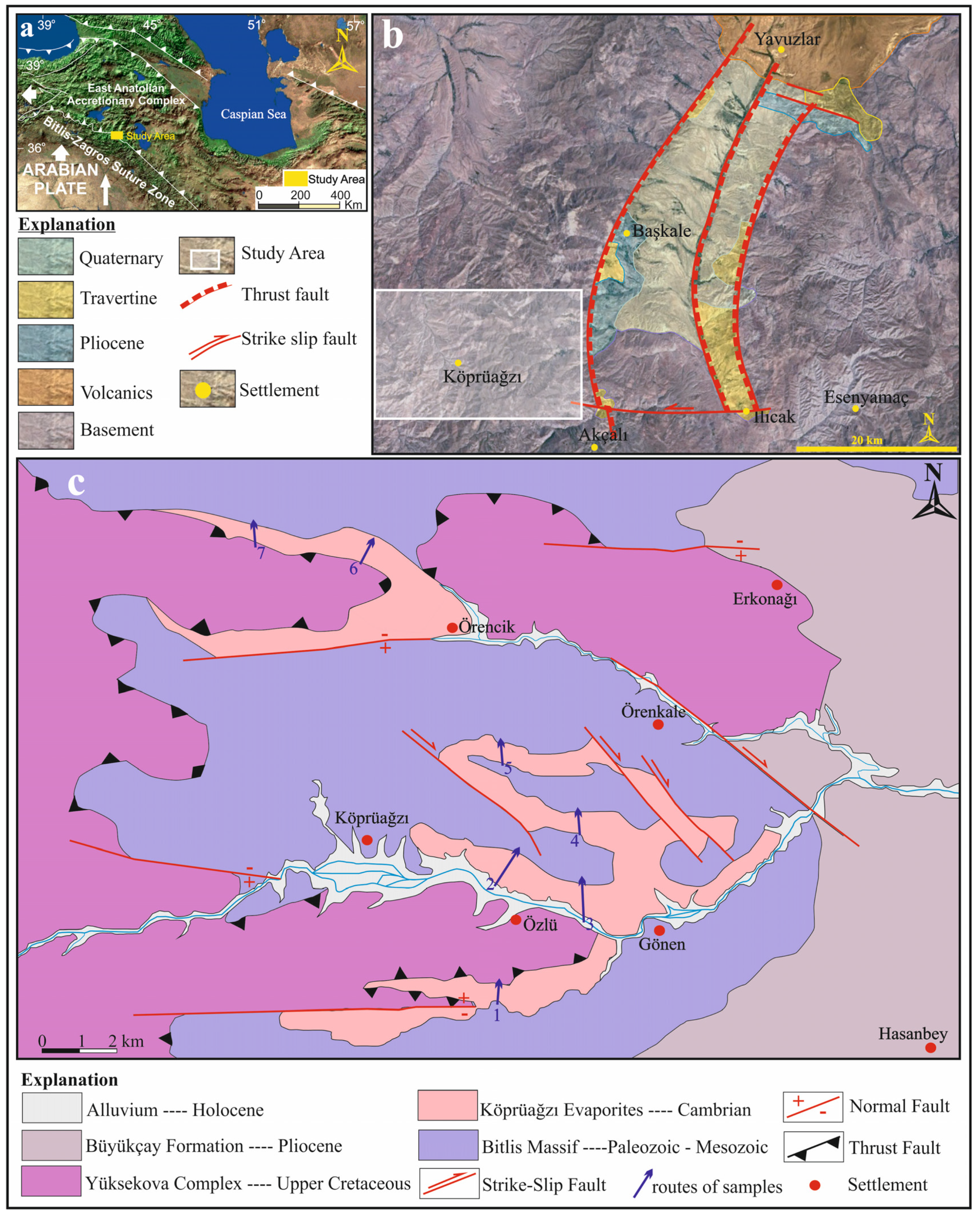
2. Geological Settings
3. Methodology
4. Results
4.1. Sedimentological Aspects of the Köprüağzı Evaporites
4.2. Petrography
4.3. Mineralogy
4.4. Element Geochemistry
4.5. Isotope Geochemistry
5. Discussion
5.1. Paleoenvironmental Conditions
5.1.1. Sedimentological—Petrographical Interpretation
5.1.2. Mineralogical Interpretation
5.1.3. Elemental Analyses Interpretation
5.2. Origin, Age and Source of the Köprüağzı Evaporites

6. Conclusions
Author Contributions
Funding
Data Availability Statement
Acknowledgments
Conflicts of Interest
References
- Warren, J.K. Evaporites: A Geological Compendium, 2nd ed.; Springer: Berlin/Heidelberg, Germany, 2016. [Google Scholar]
- Bukowski, K.; Czapowski, G.; Karoli, S.; Babel, M. Sedimentology and geochemistry of the Middle Miocene (Badenian) salt-bearing succession from East Slovakian Basin (Zbudza Formation). Geol. Soc. Lond. Spec. Publ. 2007, 285, 247–264. [Google Scholar] [CrossRef]
- Şengör, A.M.C.; Yılmaz, Y. Tethyan evolution of Turkey: A plate tectonic approach. Tectonophysics 1981, 75, 181–241. [Google Scholar] [CrossRef]
- Koçyiğit, A.; Yılmaz, A.; Adamia, S.; Kuloshvili, S. Neotectonics of East Anatoloian Plateau (Turkey) and Lesser Caucasus. Implication for transition from thrusting to stirike-slip faulting. Geodin. Acta 2001, 14, 177–195. [Google Scholar] [CrossRef]
- Şaroğlu, F.; Yılmaz, Y. Doğu Anadolu’da Neotektoniğin jeolojik gelişime başlıca etkileri. Bull. Miner. Res. Explor. 1986, 107, 73–94. [Google Scholar]
- Şengör, A.M.C. Turkey’nin neotektoniğinin esasları, 1st ed.; Turkey Jeoloji Kurumu: Ankara, Turkey, 1980; 40p. [Google Scholar]
- Koçyiğit, A. Sütlüce (Hakkâri) Depreminin Kaynağı: (Başkale fay Kuşağı, GD Turkey); Deprem Sempozyumu, Kocaeli, 23–25 Mart; Koceli Üniversitesi: Kocaeli, Turkey.
- Acarlar, M.; Türkecan, A. Başkale (Van) Batı-Kuzeybatısının Jeolojisi, 1st ed.; Min. Res. Exp.: Ankara, Turkey, 1986; 87p. [Google Scholar]
- Çevikbaş, A. Başkale (Van) Yöresinin Jeolojisi, 1st ed.; Min. Res. Exp.: Ankara, Turkey, 1986; 70p. [Google Scholar]
- Perinçek, D. Hakkâri İli ve dolayının stratigrafisi (Güneydoğu Anadolu-Turkey). Turkey Pet. Jeologları Derneği Bülteni 1990, 2, 21–68. [Google Scholar]
- Şen, A.M.; Bilgin, Z.A.; Erkal, T.; Elibol, E.; Güner, E.; Hakyemez, H.Y.; Gedik, İ.; Uğuz, M.F.; Acarlar, M.; Umut, M. Van Gölü Doğu ve Kuzeyinin Jeolojisi, 1st ed.; Min. Res. Exp.: Ankara, Turkey, 1991; 82p. [Google Scholar]
- Şenel, M. 1:100.000 ölçekli Turkey Jeoloji Haritaları, Hâkkari M51 Paftası, 1st ed.; Min. Res. Exp.: Ankara, Turkey, 2007; 55p. [Google Scholar]
- Sağlam Selçuk, A.; Düzgün, M. Başkale Fay Zonu’nun tektonik jeomorfolojisi. Bull. Miner. Res. Explor. 2017, 155, 33–47. [Google Scholar]
- Şengör, A.C.; Özeren, S.; Genç, T.; Zor, E. East Anatolian high plateau as a mantlesupported, north-south shortened domal structure. Geophys. Res. Lett. 2003, 30, 1–4. [Google Scholar] [CrossRef]
- Açlan, M.; Altun, Y. Syn-collisional I-type Esenköy Pluton (Eastern Anatolia-Turkey): An indication for collision between Arabian and Eurasian plates. J. Afr. Earth Sci. 2018, 142, 1–11. [Google Scholar] [CrossRef]
- Topuz, G.; Candan, O.; Zack, T.; Yılmaz, A. East Anatolian plateau constructed over a continental basement: No evidence for the East Anatolian accretionary complex. Geology 2017, 45, 791–794. [Google Scholar] [CrossRef]
- Topuz, G.; Altherr, R.; Schwarz, W.H.; Dokuz, A.; Meyer, H.P. Variscan amphibolite facies rocks from the Kurtoğlu metamorphic complex, Gümüşhane area, eastern Pontides Turkey. Int. J. Earth Sci. 2007, 96, 861–873. [Google Scholar] [CrossRef]
- Berberian, M.; King, G.C.P. Towards a paleogeography and tectonic evolution of lran. Can. J. Earth Sci. 1981, 18, 210–265. [Google Scholar] [CrossRef]
- Yılmaz, A.; Yazgan, E. Structural evolution of the eastern Taurus in the Cretaceous-Tertiary Period. In Proceedings of the International Earth Sciences Colloquium on the Aegean Regions, İzmir, Turkey, 1990. [Google Scholar]
- Ternek, Z. Van Gölü güneydoğu bölgesinin jeolojisi. TJK Bull. 1953, 4, 1–27. [Google Scholar]
- Yılmaz, O. Cacas bölgesi (Bitlis Masifi) kayaçlarının petrografik ve stratigrafik incelenmesi. TJK Bull. 1975, 18, 33–41. [Google Scholar]
- Ustaömer, P.A.; Ustaömer, T.; Collins, A.S.; Robertson, A.H.F. Cadomian (Ediacaran–Cambrian) arc magmatism in the Bitlis Massif, SE Turkey: Magmatism along the developing northern margin of Gondwana. Tectonophysics 2009, 473, 99–112. [Google Scholar] [CrossRef]
- Yılmaz, O. Etude Petrographique et Geochronologique de la Region de Cacas. Ph.D. Thesis, Universite Scientifique et Médicale de Grenoble, La Tronche, France, 1971; 225p. [Google Scholar]
- Genç, S. Petrography, metamorphism and genesis of metamorphics in the Çökekyazı Gökay (Hizan, Bitlis) area of the Bitlis massif. Turkey Jeol. Bülteni 1990, 33, 1–14. [Google Scholar]
- Norrish, K.; Chappel, B.W. X-ray fluorescence spectrometry. In Physical Methods in Determinative Mineralogy; Zussman, J., Ed.; Academic Press: Cambridge, MA, USA, 1977; pp. 201–272. [Google Scholar]
- MacNamara, J.; Thode, H.G. Comparison of the isotopic composition of terrestrial and meteoritic sulfur. Phys. Rev. 1950, 78, 307–308. [Google Scholar] [CrossRef]
- Baertschi, P. Absolute 18O content of Standard Mean Ocean Water. Earth Planet. Sci. Lett. 1976, 31, 341. [Google Scholar] [CrossRef]
- Köksal, S.; Toksoy-Köksal, F.; Göncüoğlu, M.C. Petrogenesis and geodynamics of plagiogranites from Central Turkey (Ekecikdağ/Aksaray): New geochemical and isotopic data for generation in an arc basin system within the northern branch of Neotethys. Int. J. Earth Sci. 2017, 106, 1181–1203. [Google Scholar] [CrossRef]
- Schreiber, B.C.; Freidman, G.M.; Decima, A.; Schreiber, E. Depositional environments of Upper Miocene (Messinian) evaporite deposites of the Silician Basin. Sedimentology 1976, 23, 729–760. [Google Scholar] [CrossRef]
- Orti, F.; Rosell, L. The Ninyerola Gypsum unit: An example of cyclic, lacustrine sedimentation (Middle Miocene, E Spain). J. Iber. Geol. 2007, 33, 249–260. [Google Scholar]
- Cody, R.D.; Cody, A.M. Gypsum nucleation and crystal morphology in analog saline terrestrial environments. J. Sediment. Res. 1988, 582, 247–255. [Google Scholar]
- Sarg, J.F. The sequence stratigraphy, sedimentology, and economic importance of evaporite-carbonate transitions: A review. Sediment. Geol. 2001, 140, 9–42. [Google Scholar] [CrossRef]
- Mahboudi, A.; Moussavi-Harami, R.; Carpenter, S.J.; Aghaei, A.; Collins, L.B. Petrographical and geochemical evidences for paragenetic sequence interpretation of diagenesis in mixed siliciclastic–carbonate sediments: Mozduran Formation (Upper Jurassic), south of Agh-Darband, NE Iran. Carbonates Evaporites 2010, 25, 231–246. [Google Scholar] [CrossRef]
- Kinsman, D.J.J. Gypsum and anhydrite of recent age, Trucial coast, Persian Gulf. In Second Symposium on Salt; Northern Ohio Geological Society: Cleveland, OH, USA, 1966. [Google Scholar]
- Yağmurlu, F.; Helvacı, C. Sedimentological characteristics and facies of the evaporite-bearing Kirmir Formation (Neogene), Beypazari Basin, central Anatolia, Turkey. Sedimentology 1994, 41, 847–860. [Google Scholar] [CrossRef]
- Koşun, E.; Çiner, A. Zara güneyi (Sivas Havzası) karasal-sığ denizel Miyosen çökellerinin litostratigrafisi ve fasiyes özellikleri. Bull. Min. Res. Exp. 2002, 125, 65–88. [Google Scholar]
- Warren, J.K. Evaporites; Blackwell Science: Hoboken, NJ, USA, 1999; 1035p. [Google Scholar]
- Hardie, L.A.; Smoot, J.P.; Eugster, H.P. Saline lakes and their deposits: A sedimentological approach. In Modern and Ancient Lakes Sediments; Matter, A., Tucker, M.E., Eds.; Int. Assoc. Sedimentol. Spec. Publ.: London, UK, 1978; Volume 2, pp. 7–41. [Google Scholar]
- Handford, C.R. Sedimantology and evaporite genesis in a Holocene continental-sabkha playa basin Bristol Dry Lake, California. Sedimentology 1982, 29, 239–253. [Google Scholar] [CrossRef]
- Schreiber, B.C.; Decima, A. Sedimentary facies produced under evaporitic environments: A review. Memorie Societa Geologica Italiana 1976, 16, 111–116. [Google Scholar]
- Aref, M.; Attia, O.; Wali, A. Facies and depositional environment of the Holocene evaporites in the Ras Shukeir area, gulf of Suez, Egypt. Sediment. Geol. 1997, 110, 123–145. [Google Scholar] [CrossRef]
- Calvert, S.E.; Pedersen, T.F. Sedimentary geochemistry of manganese: Implications fort he environment of formation of manganiferous black shales. Econ. Geol. 1996, 91, 36–47. [Google Scholar] [CrossRef]
- Vallentyne, J.R. Isolation of pyrite spherules from recent sediments. Limnol. Oceanogr. 1963, 8, 16–30. [Google Scholar] [CrossRef]
- Chamley, H. Clay Sedimentology; Springer: Berlin/Heidelberg, Germany, 1989; pp. 623–668. [Google Scholar]
- Sümengen, M. Başkale-L52 Paftası: Turkey 1/100.000 ölçekli Jeoloji Haritaları Serisi, 1st ed.; Min. Res. Exp.: Ankara, Turkey, 1980; 63p. [Google Scholar]
- Kushnir, J. The composition and origin of brines during the Messinian desiccation event in the Mediterrnnean basin as deduced from concentrations of ions coprccipitated with gypsum and anhydrite. Chem. Geol. 1982, 35, 333–350. [Google Scholar] [CrossRef]
- Palmer, M.R.; Helvacı, C.; Fallick, A.E. Sulphur, sulphate oxygen and strontium isotope composition of Cenozoic Turkish evaporites. Chem. Geol. 2004, 209, 341–356. [Google Scholar] [CrossRef]
- Pye, K.; Krinsley, D.H. Diagenetic carbonate and evaporite minerals in Rotliegend aeolian sandstones of the southern North Sea: Their nature and relationship to secondary porosity. Clay Miner. 1986, 21, 443–457. [Google Scholar] [CrossRef]
- Haug, G.H.; Gunther, D.; Peterson, L.C.; Sigman, D.M.; Highen, K.A.; Aeschlimann, B. Climate and the collapse of Maya Civilization. Science 2003, 299, 1731–1735. [Google Scholar] [CrossRef]
- Reinhardt, N.; Proenza, J.A.; Villanova-de-Benavent, C.; Aiglsperger, T.; Bover-Arnal, T.; Torro, L.; Salas, R.; Dziggel, A. Geochemistry and mineralogy of rare earth elements (Ree) in bauxitic ores of the Catalan coastal range, NE Spain. Minerals 2018, 8, 562. [Google Scholar] [CrossRef]
- Pettijohn, F.J.; Potter, P.E.; Siever, R. Sand and Sandstone; Springer: Berlin/Heidelberg, Germany, 1973; p. 631. [Google Scholar]
- Li, B.L.; Zhou, C.H. Climatic variation and desertification in West sandy land of northeast China plain. J. Nat. Resour. 2001, 16, 234–239. [Google Scholar]
- Adatte, T.; Keller, G.; Stinnesbeck, W. Late Cretaceous to early Paleocene climate and sea-level fluctuations. the Tunisian record. Palaeogeogr. Palaeoclimatol. Palaeoecol. 2002, 178, 165–196. [Google Scholar] [CrossRef]
- Khormali, F.; Abtahi, A.; Owliaei, H.R. Late Mesozoic-Cenozoic clay mineral rocks of southern Iran and their palaeoclimatic implications. Clay Miner. 2005, 40, 191–203. [Google Scholar] [CrossRef]
- Deconinck, E.; Hancock, T.; Coomans, D.; Massart, D.L.; Vander Heyden, Y. Classification of drugs in absorption classes using the classification and regression trees (CART) methodology. J. Pharm. Biomed. Anal. 2005, 39, 91–103. [Google Scholar] [CrossRef]
- Hernandez-Hinojosa, V.; Montiel-Garcia, P.C.; Armstrong-Altrin, J.S.; Kasper-Zubillaga, J.J. Textural and geochemical characteristics of beach sands along the western Gulf of Mexico. Carpathian J. Earth Environ. Sci. 2018, 13, 161–174. [Google Scholar] [CrossRef]
- Roy, P.D.; Smykatz-Kloss, W.; Sinha, R. Late Holocene geochemical history inferred from Sambhar and Didwana playa sediments, Thar Desert, India: Comparison and synthesis. Quat. Int. 2006, 144, 84–98. [Google Scholar] [CrossRef]
- Usdowski, E. Der Einbau von Sr in Gips und Anhydrit. In Annual Meeting Deutsche Mineral.; Arnold Gesell-Frances: Berlin, Germany, 1967. [Google Scholar]
- Hasselöv, M.; Lyvén, D.; Haraldsson, C.; Sirinawin, W. Determation of continous size and trace element distribution of field-flow fractionation with ICPMS. Anal. Chem. 1999, 71, 3497–3502. [Google Scholar] [CrossRef]
- Krauskopf, K.B. Introduction to Geochemistry; McGraw-Hill Book Company: New York, NY, USA, 1979. [Google Scholar]
- Rushdi, A.I.; McManus, J.; Collier, R.W. Marine barite and celestite saturation in seawater. Mar. Chem. 2000, 69, 19–31. [Google Scholar] [CrossRef]
- Playa, E.; Cendon, D.I.; Trave, A.; Chivas, A.; Garcia, A.R. Non-marine evaporites with both inherited marine and continental signatures. the Gulf of Carpentaria, Australia, at ~70 ka. Sediment. Geol. 2007, 201, 267–285. [Google Scholar] [CrossRef]
- Bahadori, A.; Carranza, E.J.M.; Soleimani, B. Geochemical analysis of evaporite sedimentation in Gachsaran Formation, Zeloi oil field, southwest Iran. J. Geochem. Explor. 2011, 111, 97–112. [Google Scholar] [CrossRef]
- Chen, Z.; Ming, Z.; Qiang, J.; Yongjun, R. Distribution of sterane maturity parameters in a lacustrine basin and their control factors. A case study from the Dongying Sag, East China. Pet. Sci. 2011, 8, 290–301. [Google Scholar] [CrossRef]
- Averty, K.B.; Paytan, A. Empirical partition coefficients for Sr and Ca in marine barite: Implications for reconstructing seawater Sr and Ca concentrations. Geochem. Geophys. Geosystems 2003, 4, 1–14. [Google Scholar] [CrossRef]
- Krefci-Graf, K. Geochemische Faziesdiagnostik. Freib. Forsch. 1966, 224, 1–80. [Google Scholar]
- Wignall, P.B.; Yers, K.J. Interpreting benthic oxygen levels in mudrocks: A new approach. Geology 1988, 16, 452–555. [Google Scholar] [CrossRef]
- Kumar, A.; Verma, J.P. Does plant microbe interaction confer stress tolerance in plants: A review? Microbiol. Res. 2018, 207, 41–52. [Google Scholar] [CrossRef]
- Hallberg, R.O. A geochemical method for investigation of palaeoredox conditions in sediments. Ambio Spec. Rep. 1976, 4, 139–147. [Google Scholar]
- Raiswell, R.; Plant, J. The incorporation of trace elements into pyrite during diagenesis of black shales, Yorkshire, England. Econ. Geol. 1980, 75, 684–699. [Google Scholar] [CrossRef]
- Patteson, J.H.; Ramsden, A.R.; Dale, L.S.; Fardy, J.J. Geochemistry and mineralogical residences of trace elements in oil shales from Julia Creek, Queensland, Australia. Chem. Geol. 1986, 55, 1–16. [Google Scholar] [CrossRef]
- Guo, P.; Chiyang, L.; Peng, W.; Ke, W.; Haili, Y.; Li, B. Geochemical behavior of rare elements in Paleogene saline lake sediments of the Qaidam Basin NE Tibetan Plateau. Carbonates Evaporites 2019, 34, 359–372. [Google Scholar] [CrossRef]
- Gaillardet, J.; Viers, J.; Dupre, B. Trace elements in river waters. In Treatise on Geochemistry; Holland, H.D., Turekian, K.K., Eds.; Elsevier: Amsterdam, The Netherlands, 2004; pp. 225–272. [Google Scholar]
- McArthur, J.M.; Howarth, R.J.; Bailey, T.R. Strontium isotope stratigraphy: Best fit to the marine Sr-isotope curve for 0-509 Ma and accompanying look-up table for deriving numerical age. J. Geol. 2001, 109, 155–170. [Google Scholar] [CrossRef]
- Lu, F.H.; Meyers, W.J. Sr, S, and O (SO4) isotopes and the depositional environments of the Upper Miocene evaporites, Spain. J. Sediment. Res. 2003, 73, 444–450. [Google Scholar] [CrossRef]
- Banner, J.L.; Musgrove, M.; Capo, R.C. Tracing groundwater evolution in a limestone aquifer using Sr isotopes: Effects of multiple sources of dissolved ions and mineral-solution reactions. Geology 1994, 22, 681–690. [Google Scholar] [CrossRef]
- Veizer, J.; Compston, W. 87Sr/86Sr composition of sea water during the Phanerozoic. Geochim. Et Cosmochim. Acta 1974, 38, 14611484. [Google Scholar] [CrossRef]
- Burke, W.H.; Denison, R.E.; Hetherington, E.A.; Koepnick, R.B.; Nelson, H.F.; Otto, J.B. Variation of seawater 87Sr/86Sr throughout Phanerozoic time. Geology 1982, 10, 516–519. [Google Scholar] [CrossRef]
- Veizer, J.; Compston, W.; Clauer, N.; Schidlowski, M. 87/86Sr in Late Proterozoic carbonates: Evidence for a mantle event at 900 Ma ago. Geochim. Cosmochim. Acta 1983, 47, 295–302. [Google Scholar] [CrossRef]
- Derry, L.A.; Brasier, M.D.; Corfield, R.M.; Rozanov, A.Y.; Zhuravlev, A.Y. Sr and C isotopes in Lower Cambrian carbonates from the Siberian craton: A paleoenvironmental record during the Cambrian explosion. Earth Planet. Sci. Lett. 1994, 128, 671–681. [Google Scholar] [CrossRef]
- Veizer, J.; Compston, W. 87/86Sr in Precambrian carbonates as an index of crustal evolution. Geochim. Et Cosmochim. Acta 1976, 40, 905–914. [Google Scholar] [CrossRef]
- Pearce, J.A.; Bender, J.F.; De Long, S.E.; Kidd, W.S.F.; Low, P.J.; Güner, Y.; Şaroğlu, F.; Yılmaz, Y.; Moorbath, S.; Mitchell, J.G. Genesis of collision volcanism in Eastern Anatolia, Turkey. J. Volcanol. Geotherm. Res. 1990, 44, 189–229. [Google Scholar] [CrossRef]
- Arslan, M.; Temizel, İ.; Abdioğlu, E.; Kolaylı, H.; Yücel, C.; Boztuğ, D.; Şen, C. 40Ar–39Ar dating, whole-rock and Sr–Nd–Pb isotope geochemistry of post-collisional Eocene volcanic rocks in the southern part of the Eastern Pontides (NE Turkey): Implications for magma evolution in extension-induced origin. Contrib. Mineral. Petrol. 2013, 166, 113–142. [Google Scholar] [CrossRef]
- Holser, W.T. Catastrophic chemical events in the history of the oceans. Nature 1977, 267, 403–408. [Google Scholar] [CrossRef]
- Claypool, G.E.; Holser, W.T.; Kaplan, I.R.; Sakai, H.; Zak, I. The age curves of sulfur and oxygen isotopes in marine sulfate and their mutual interpretation. Chem. Geol. 1980, 28, 199–260. [Google Scholar] [CrossRef]
- Strauss, H. The isotopic composition of sedimentary sulfur through time. Palaeogeogr. Palaeoclimatol. Palaeoecol. 1997, 132, 97–118. [Google Scholar] [CrossRef]
- Schröder, S.; Bekker, A.; Beukes, N.J.; Strauss, H.; Van Niekerk, H.S. Rise in seawater sulphate concentration associated with the Paleoproterozoic positive carbon isotope excursion: Evidence from sulphate evaporites in the ~2.2–2.1 Gyr shallow-marine Lucknow Formation, South Africa. Terra Nova 2008, 20, 108–117. [Google Scholar] [CrossRef]
- Shields, G.A.; Mills, B.J.W. Sulfur cycle imbalance and environmental change during the Ediacaran Period. Estud. Geológicos 2019, 75, e114. [Google Scholar] [CrossRef]
- Holser, W.T.; Kaplan, I.R. Isotope geochemistry of sedimentary sulfates. Chem. Geol. 1966, 1, 93–135. [Google Scholar] [CrossRef]
- Barkov, N.I.; Nikolaev, V.I.; Strizhov, V.P. On the genesis of mirabilite in the McMurdo Sound region, Antarctica. Lithol. Miner. Resour. 1995, 30, 374–379. [Google Scholar]
- Zak, I.; Sakai, H.; Kaplan, I.R. Factors controlling the 18O/16O and 34S/32S isotope tios of ocean sulfates, evaporites and interstitial sulfates from modern deep sea sediments. In Isotope Marine Chemistry; Goldberg, E.D., Horibe, Y., Saruhashi, K., Eds.; Rokakuho: Tokyo, Japan, 1980; pp. 339–373. [Google Scholar]
- Cavazza, W.; Cattò, S.; Zattin, M.; Okay, A.I.; Reiners, P. Thermochronology of the Miocene Arabia-Eurasia collision zone of southeastern, Turkey. Geosphere 2018, 14, 5. [Google Scholar] [CrossRef]
- Kent, P.E. The emergent Hormoz salt plugs of southern Iran. J. Pet. Geol. 1979, 2, 117–144. [Google Scholar] [CrossRef]
- Houghton, M.L. Geochemistry of the Proterozoic Hormuz Evaporites, Southern Iran. Master’s Thesis, University of Oregon, Eugene, OR, USA, 1980. [Google Scholar]
- Soffel, H.C.; Forster, H. Polar wander path of Central East Iran microplate including new results. Neues Jahrb. Für Geol. Und Paläontologie 1984, 168, 165–172. [Google Scholar] [CrossRef]
- Banerjee, D.M.; Mazumdar, A. On the Late Neoproterozoic-Early Cambrian transition events in parts of East Gondwanaland. Gondwana Res. 1999, 2, 199–211. [Google Scholar] [CrossRef]
- Alavi, M. Regional stratigraphy of the Zagros Fold-Thrust Belt of Iran and its proforeland evolution. Am. J. Sci. 2004, 304, 1–20. [Google Scholar] [CrossRef]
- Talbot, C.; Aftabi, P.; Chemia, Z. Potash in a salt mushroom at Hormoz Island, Hormoz Strait, Iran. Ore Geol. Rev. 2008, 35, 317–332. [Google Scholar] [CrossRef]
- Motamedi, H.; Sepehr, M.; Sherkati, S.; Pourkermani, M. Multi-Phase Hormuz salt diapirism in the Southern Zagros, SW Iran. J. Pet. Geol. 2010, 34, 29–43. [Google Scholar] [CrossRef]
- Oberhhansli, R.; Candan, O.; Bousquet, R.; Rimmele, G.; Okay, A.; Goff, J. Alpine high pressure evolution of the eastern Bitlis complex, SE Turkey. Geol. Soc. Lond. Spec. Publ. 2010, 340, 461–483. [Google Scholar] [CrossRef]
- Scheffler, F.; Oberhansli, R.; Pourteau, A.; Immenhauser, A.; Candan, O. Sedimentologic to metamorphic processes recorded in the high-pressure/low-temperature Mesozoic Rosetta Marble of Anatolia. Int. J. Earth Sci. 2016, 105, 225–246. [Google Scholar] [CrossRef]
- Scheffler, F.; Immenhauser, A.; Pourteau, A.; Natalicchio, M.; Candan, O.; Oberhansli, R. A lost Tethyan evaporitic basin: Evidence from a Cretaceous hemipelagic meta-selenite—Red chert association in the Eastern Mediterranean realm. Sedimentology 2019, 66, 2627–2660. [Google Scholar] [CrossRef]
- Ocakoğlu, F. Repetitive subtidal to coastal sabkha cycles from a Lower–Middle Miocene marine sequence, eastern Sivas Basin. Turk. J. Earth Sci. 2001, 10, 17–34. [Google Scholar]
- Rahimpour-Bonab, H.; Kalantarzadeh, Z. Origin of secondary potash deposits; a case from Miocene evaporites of NW Central Iran. J. Asian Earth Sci. 2005, 25, 157–166. [Google Scholar] [CrossRef]
- Rahimpour-Bonab, H.; Shariatinia, Z.; Siemann, M.G. Origin and geochemistry of Miocene marine evaporites associated with red beds: Great Kavir Basin, Central Iran. Geol. J. 2007, 42, 37–54. [Google Scholar] [CrossRef]
- Hüsing, S.K.; Zachariasse, W.J.; Van Hinsbergen, D.J.; Krijgsman, W.; İnceöz, M.; Harzhauser, M.; Mandic, O.; Kroh, A. Oligocene Miocene basin evolution in SE Anatolia, Turkey: Constraints on the closure of the eastern Tethys gateway. Geol. Soc. Lond. Spec. Publ. 2009, 311, 107–132. [Google Scholar] [CrossRef]
- Ayyıldız, T.; Varol, B.; Karakaş, Z.; Sözeri, K. Miocene evaporites in the intermountain Tuzluca–Iğdır Neogene Basin, Eastern Turkey. EGU General Assembly: Vienna, Austria, 2012. [Google Scholar]
- Kavoosi, M.A.; Sherkati, S. Depositional environments of the Kalhur Member evaporites and tectonosedimentary evolution of the Zagros fold–thrust belt during Early Miocene in south westernmost of Iran. Carbonates Evaporites 2012, 27, 55–69. [Google Scholar] [CrossRef]
- Yeşilova, Ç.; Helvacı, C. Lice Formasyonu Evaporitleri ve Killerinin Ekonomik Önemi: Baykan–Kurtalan–Şirvan Bölgesi (Siirt). J. Inst. Nat. Appl. Sci. 2012, 17, 72–83. [Google Scholar]
- Yeşilova, Ç.; Helvacı, C. Stratigraphy and sedimentology north of Batman and Siirt, Turkey. Turk. Assoc. Pet. Geol. Bull. 2013, 23, 7–49. [Google Scholar]
- Güngör Yeşilova, P.; Helvacı, C. Diagenesis and paleogeographic development of Oligocene evaporites of the Germik Formation (Kurtalan, SW Siirt), Turkey. Bull. Earth. Sci. 2013, 34, 1–22. [Google Scholar]
- Abdioğlu, E.; Arslan, M.; Aydınçakır, D.; Gündoğan, İ.; Helvacı, C. Stratigraphy, mineralogy and depositional environment of the evaporite unit in the Aşkale (Erzurum) sub-basin, Eastern Anatolia (Turkey). J. Afr. Earth Sci. 2015, 111, 100–112. [Google Scholar] [CrossRef]
- Ribes, C.; Kergaravat, C.; Bonnel, C.; Crumeyrolle, P.; Callot, J.P.; Poisson, A.; Temiz, H.; Ringenbach, J.C. Fluvial sedimentation in a salt-controlled mini-basin: Stratal patterns and facies assemblages, Sivas Basin, Turkey. Sedimentology 2015, 62, 1513–1545. [Google Scholar] [CrossRef]
- Soleimani, B.; Bahadori, A. The Miocene Gachsaran Formation evaporite cap rock, Zeloi oilfield, SW Iran. Carbonates Evaporites 2015, 30, 287–306. [Google Scholar] [CrossRef]
- Kangal, Ö.; Özgen -Erdem, N.; Varol, B. Depositional states of Eğribucak inner basin (terrestrial to marine evaporite and carbonate) from the Sivas Basin (Central Anatolia, Turkey). Turk. J. Earth Sci. 2016, 25, 127–146. [Google Scholar]
- Kergaravat, C.; Ribes, C.; Callot, J.-P.; Legeay, E.; Ringenbach, J.-C. Minibasins and salt canopies in foreland fold-and-thrust belts: The central Sivas Basin, Turkey. Tectonics 2016, 35, 1342–1366. [Google Scholar] [CrossRef]
- Varol, B.; Şen, Ş.; Ayyıldız, T.; Sözeri, K.; Karakaş, Z.; Metais, G. Sedimentology and stratigraphy of Cenozoic deposits in the Kağizman–Tuzluca Basin, northeastern Turkey. Int. J. Earth Sci. 2016, 105, 107–137. [Google Scholar] [CrossRef]
- Güngör-Yeşilova, P.; Helvacı, C. Petrographic study and geochemical investigation of the evaporites associated with Germik formation (Siirt Basin, Turkey). Carbonates Evaporites 2017, 32, 177–194. [Google Scholar] [CrossRef]
- Ribes, C.; Lopez, M.; Kergaravat, C.; Crumeyrolle, P.; Poisson, A.; Callot, J.-P.; Paquette, J.-L.; Ringenbach, J.-C. Facies partitioning and stratal pattern in salt-controlled marine to continental mini-basins: Examples from the late Oligocene to early Miocene of the Sivas Basin, Turkey. Mar. Pet. Geol. 2018, 93, 468–496. [Google Scholar] [CrossRef]
- Yeşilova, Ç.; Helvacı, C.; Carrillo, E. Evaporitic sedimentation in the Southeastern Anatolian Foreland Basin, Newinsights on the Neotethys closure. Sediment. Geol. 2018, 369, 13–27. [Google Scholar] [CrossRef]
- Güngör Yeşilova, P.; Gökmen, D. The paleodepositional environment, diagenetic and depositional conditions of the Middle-Late Miocene Koluz gypsum member (NE Van, Eastern Turkey). Carbonates Evaporites 2020, 35, 76. [Google Scholar] [CrossRef]
- Güngör Yeşilova, P.; Yeşilova, Ç. Depositional basin, diagenetic conditions and source of Miocene evaporites in the Tuzluca Basin in Northeastern Anatolia, Turkey: Geochemical evidence. Geochem. Int. 2021, 59, 1293–1310. [Google Scholar] [CrossRef]
- Güngör Yeşilova, P.; Yavuz, Ş. Sedimentological and mineralogical-petrographic characteristics of Miocene evaporitic deposits (SW Erzincan). MANAS 2021, 9, 169–183. [Google Scholar] [CrossRef]
- Müller, D.W.; Mueller, P.A. Origin and age of the Mediterranean Messinian evaporites implications from Sr isotopes. Earth Planet. Sci. Lett. 1991, 107, 1–12. [Google Scholar] [CrossRef]
- Pierre, C. Sedimentation and diagenesis in restricted marine basins. In The Marine Environment; Fritz, P., Fontes, J.C.H., Eds.; Elsevier: Amsterdam, The Netherlands, 1989; pp. 257–315. [Google Scholar]
- Veizer, J.; Godderis, Y.; François, L.M. Evidence for decoupling of atmospheric CO2 and global climate during the Phanerozoic eon. Nature 2000, 408, 698–701. [Google Scholar] [CrossRef] [PubMed]
- Taylor, B.E.; Wheeler, M.C.; Nordstrom, D.K. Oxygen and sulfur compositions of sulfate in acid mine drainage: Evidence for oxidation mechanisms. Nature 1984, 308, 538–541. [Google Scholar] [CrossRef]
- Nriagu, J.O.; Rees, C.E.; Mekhtiyeva, V.L.Y.; Lein, A.; Fritz, P.; Drimmie, R.J.; Pankina, R.G.; Robinson, B.W.; Krouse, H.R. Hydrosphere. In Stable Isotopes: Natural and Anthropogenic Sulfur in the Environment; Krouse, H.R., Grinenko, V.A., Eds.; John Wiley and Sons: Oxford, UK, 1991; pp. 177–266. [Google Scholar]
- Lu, F.H.; Meyers, W.J. Sr, S, O, SO4 isotopes and quantitative models of Messinian gypsum, the Nijar Basin, Spain (Abstract). In Proceedings of the International Applied Isotope Geochemistry (AIG-2) Conference, Calgary, AB, Canada, 1997; Available online: https://www.iagc-society.org/AGI (accessed on 2 February 2023).
- Taberner, C.; Marshall, J.D.; Hendry, J.P.; Pierre, C.; Thirlwall, M.F. Celestite formation, bacterial sulphate reduction and carbonate cementation of Eocene reefs and basinal sediments (Igualada, NE Spain). Sedimentology 2002, 49, 171–190. [Google Scholar] [CrossRef]
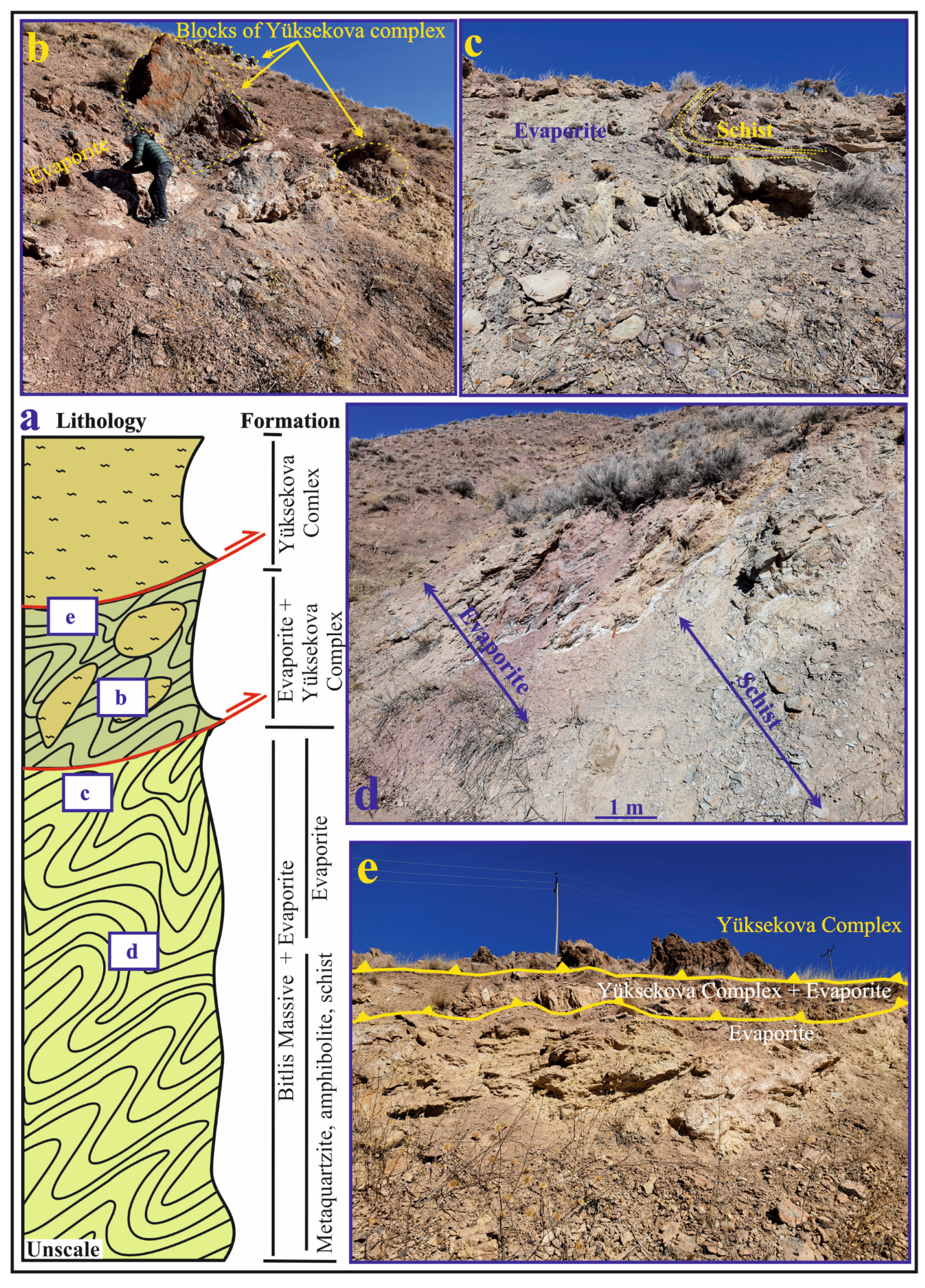
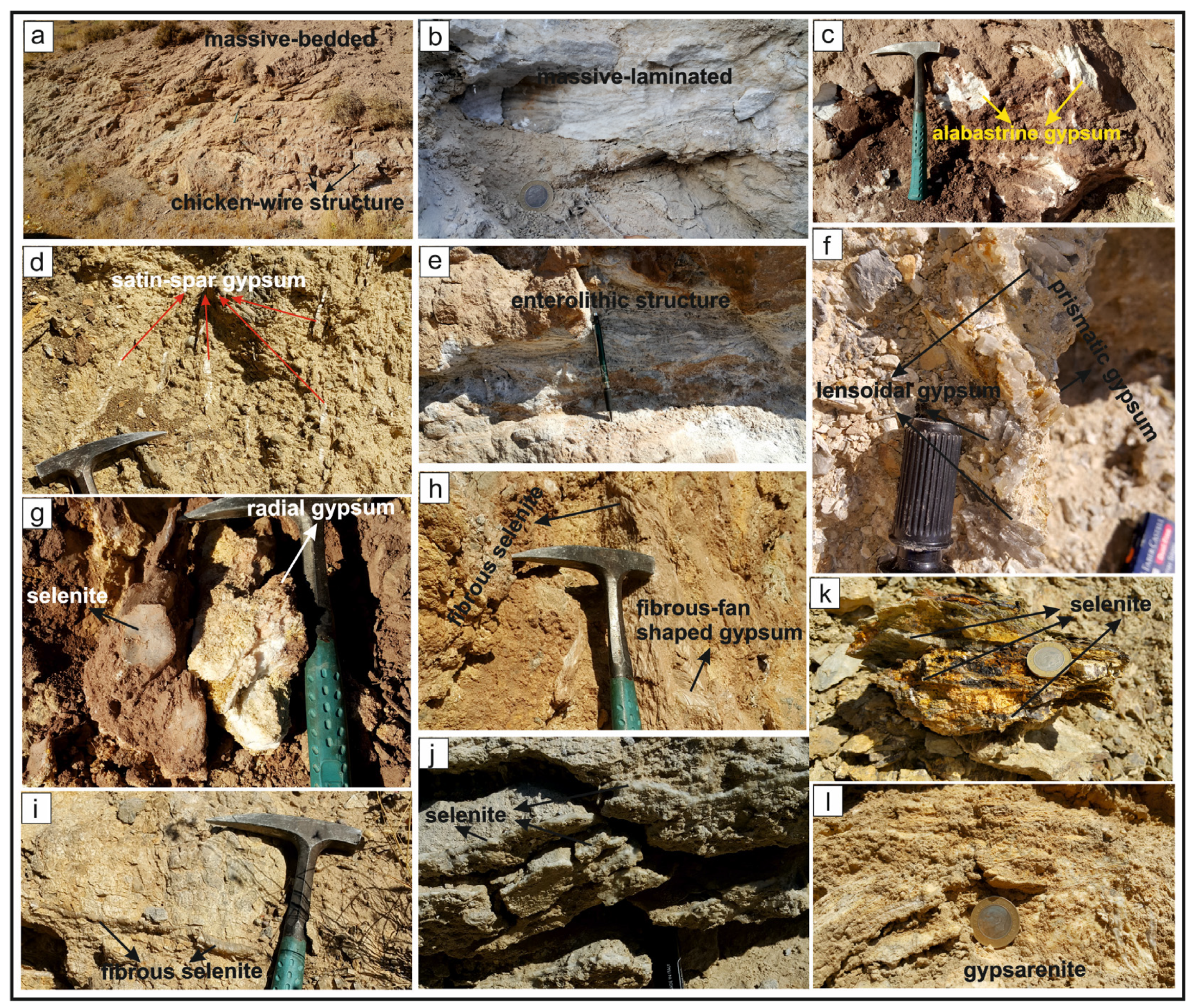
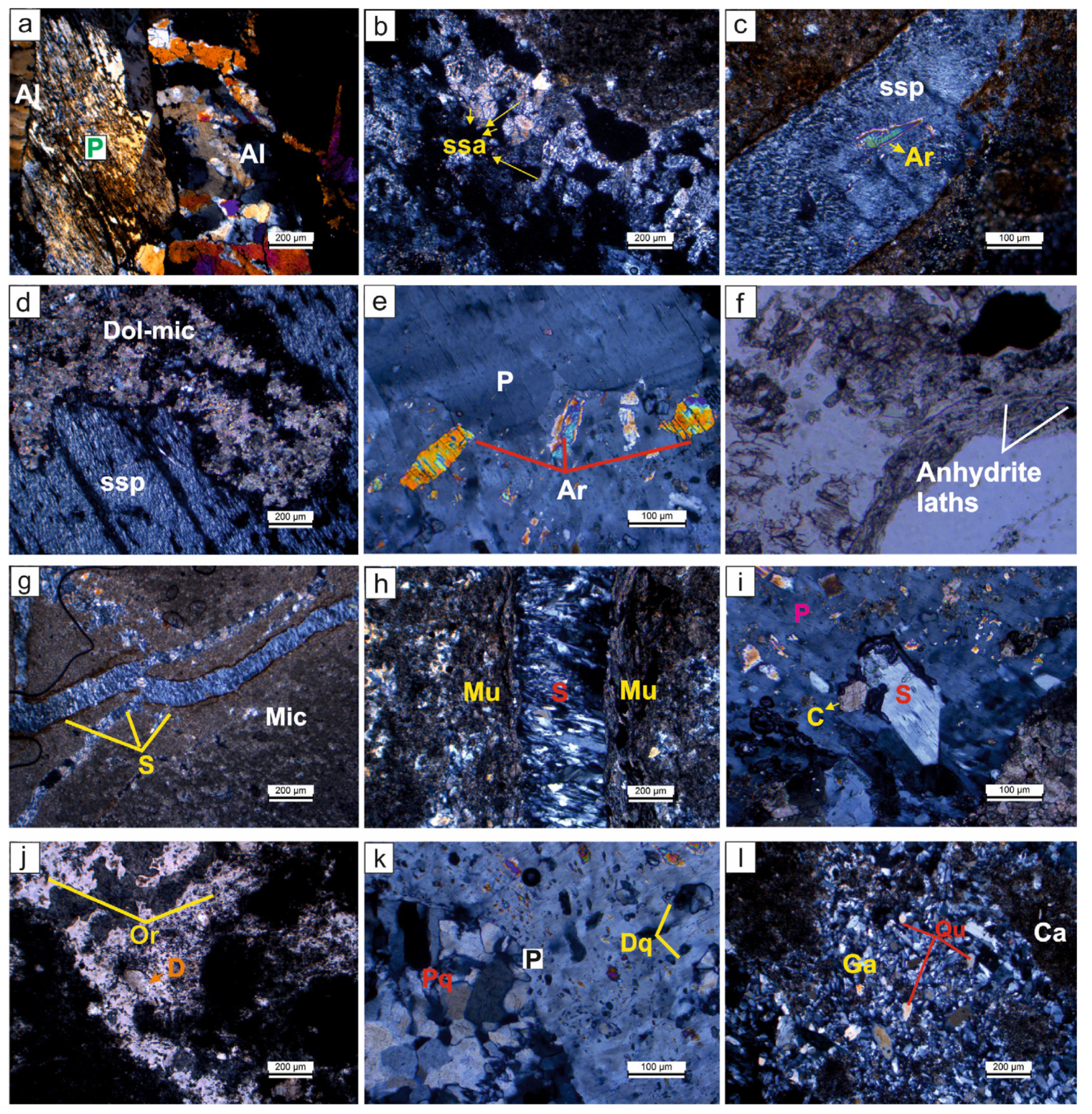
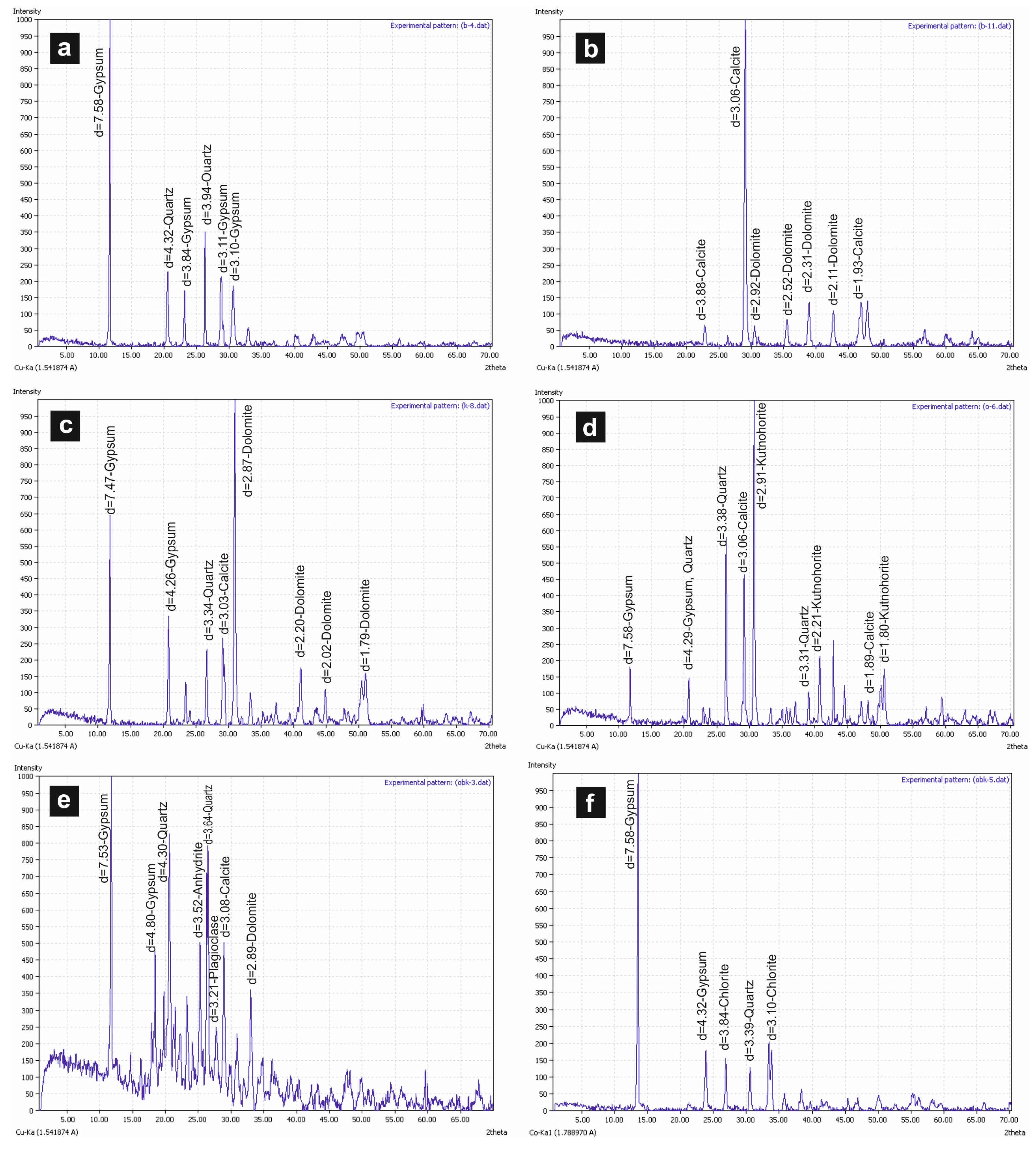
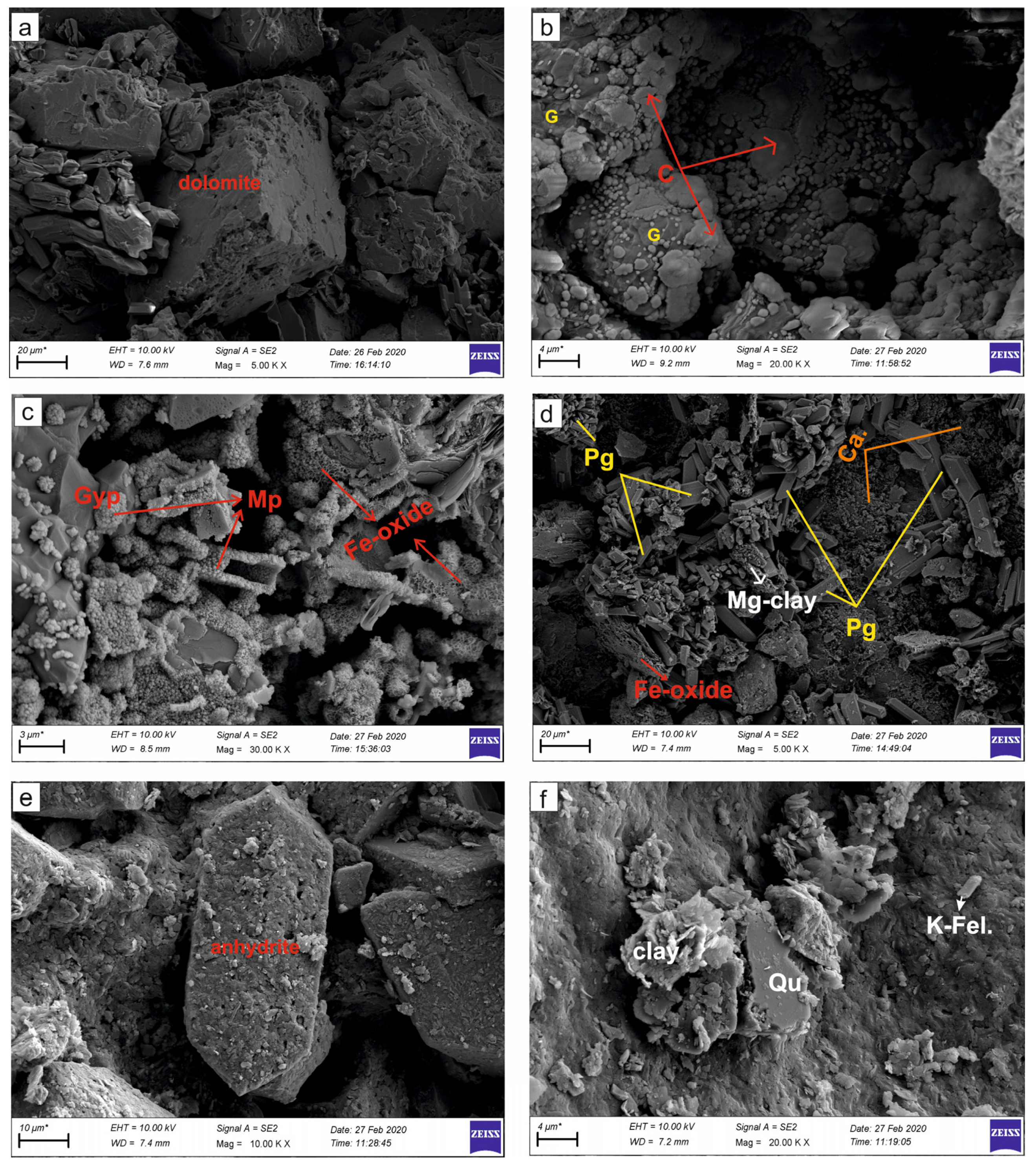
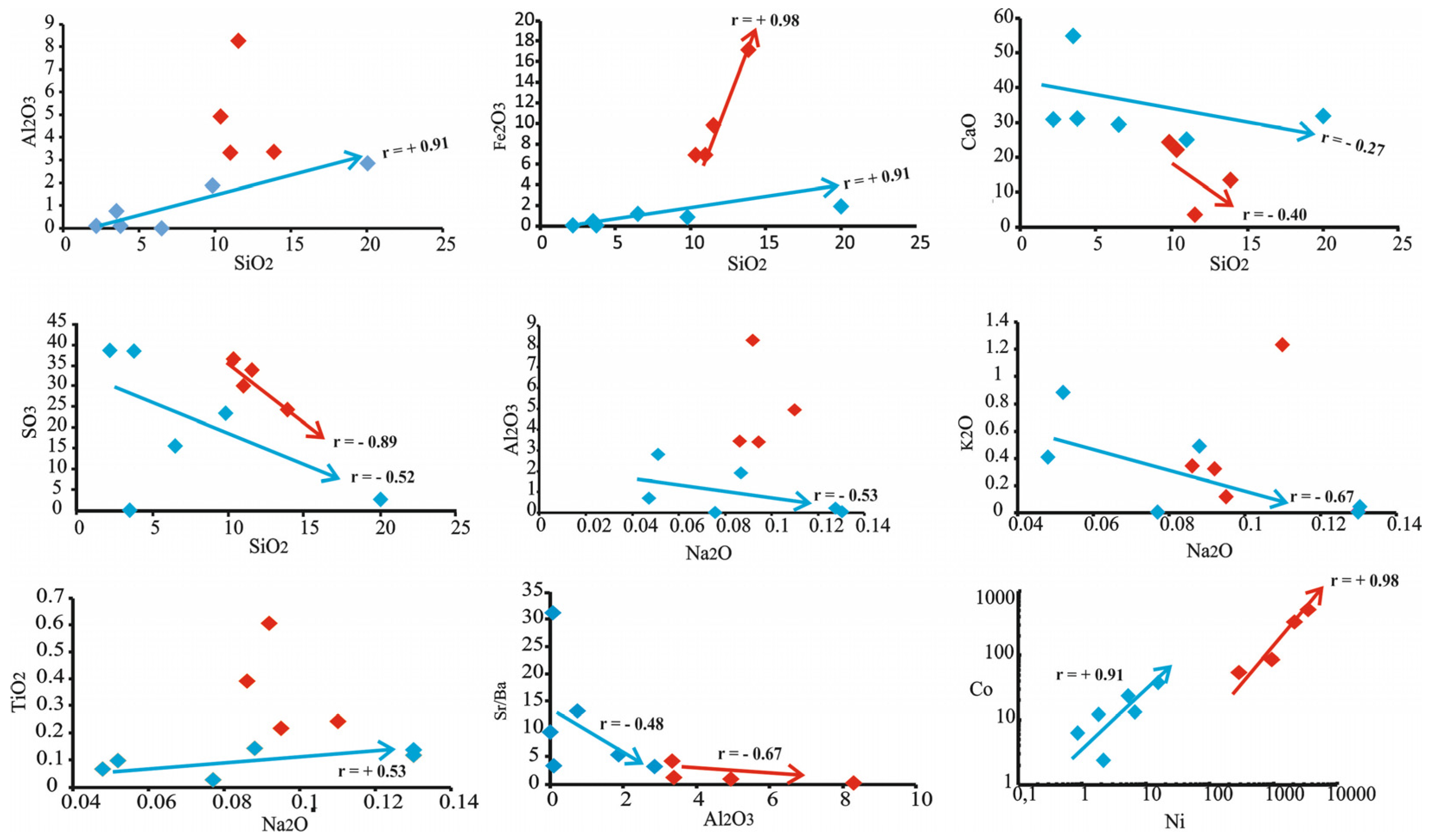
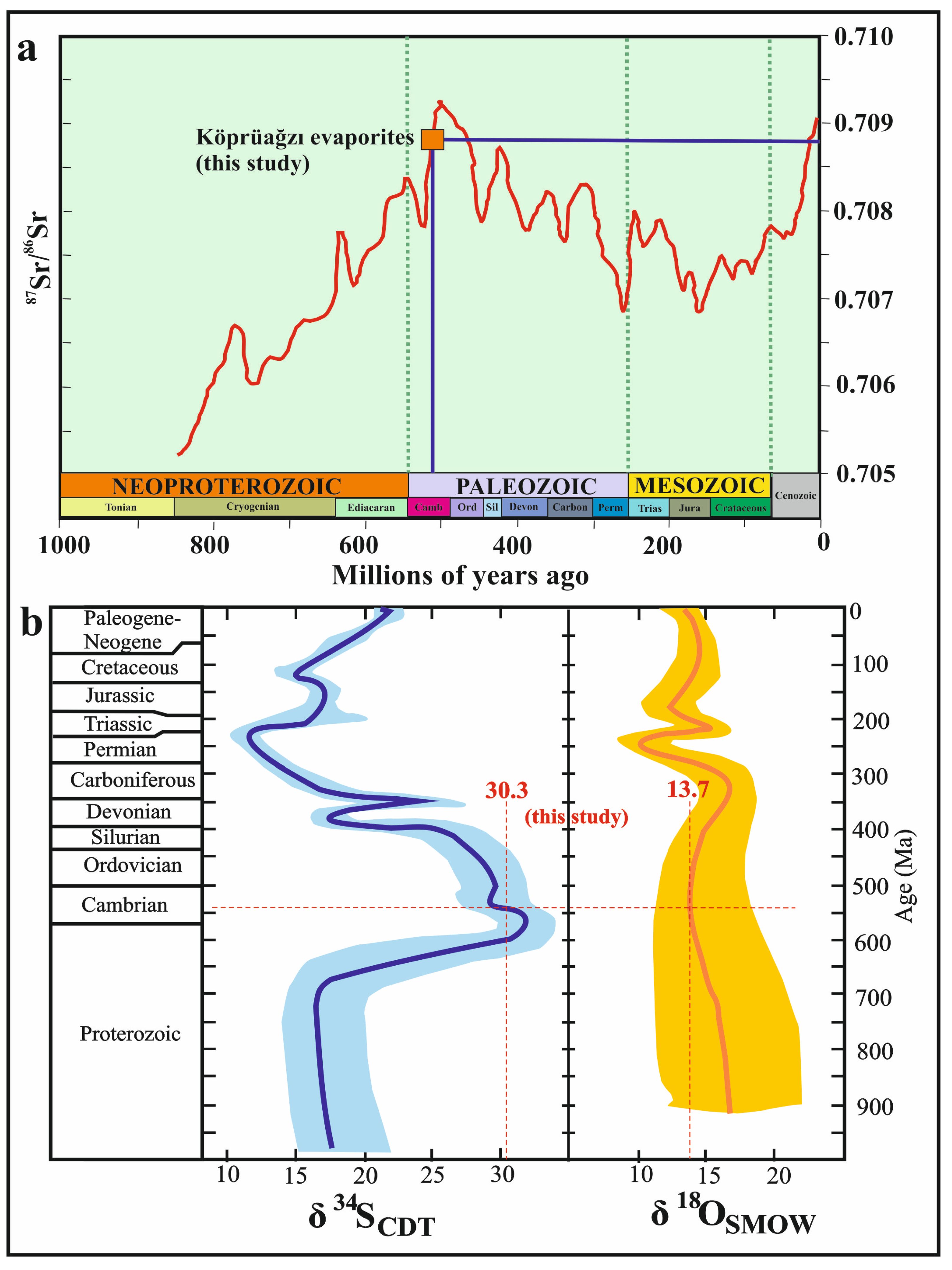
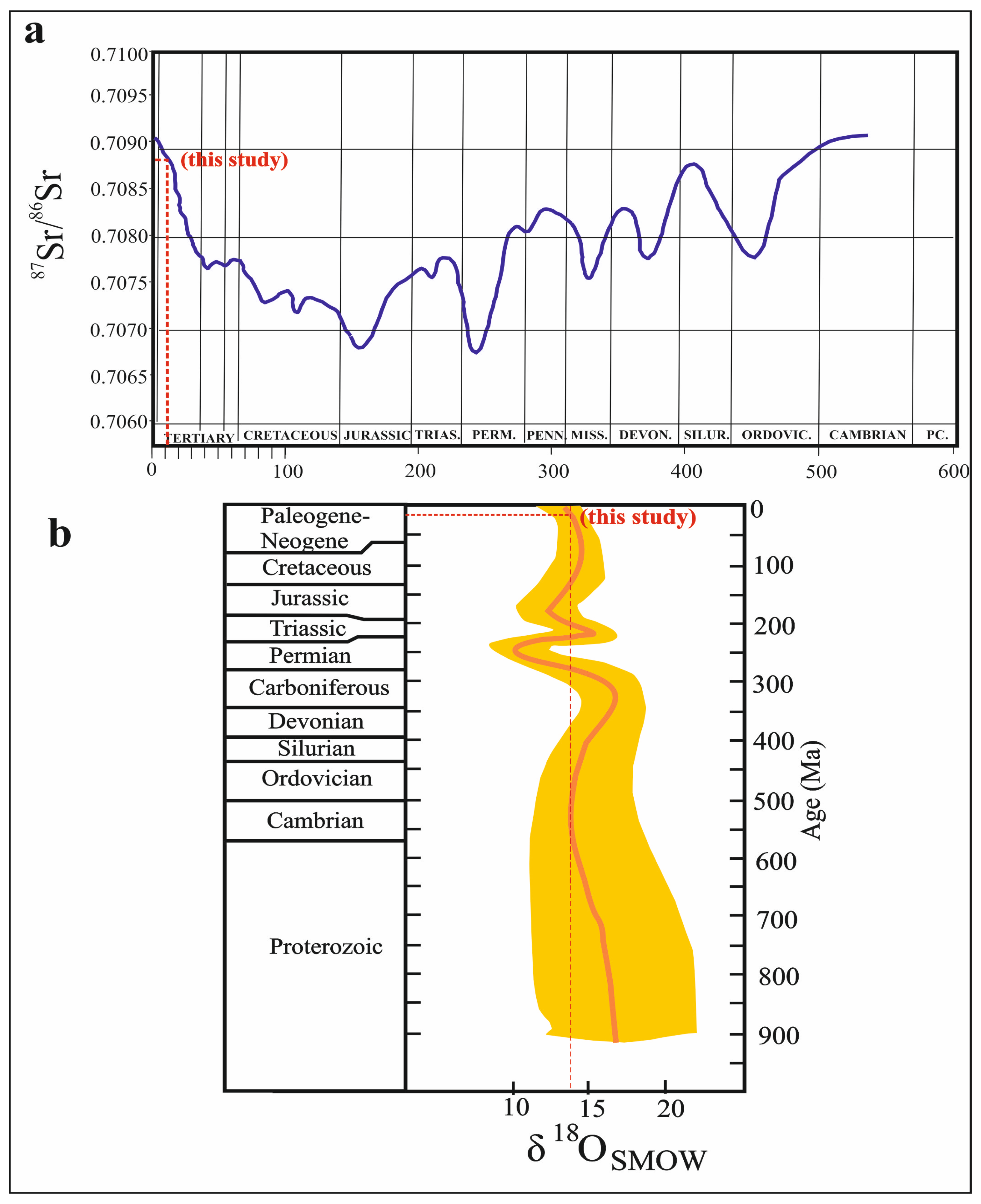
| Lithology | Anhydrite-Bearing Laminated Gypsum | Massive Gypsum | Satin-Spar | Gypsarenite | Selenite | Massive | Gypsarenite-Bearing Claystone | Laminated Gypsum-Bearing Claystone | Selenite-Bearing Mudstone | Satin- Spar Gypsum-Bearing Carbonate |
|---|---|---|---|---|---|---|---|---|---|---|
| Sample No | B–11 | B–7 | K–12 | K–8 | K–5 | O–6 | OBK–3 | OBK–7 | OBK–6 | OBK–4 |
| MgO | 0.7 | 3.6 | 1.1 | 7.4 | 1.6 | 7.5 | 1.4 | 2.2 | 4.5 | 0.6 |
| Al2O3 | 0.7 | 1.9 | 0.08 | 0.008 | 0.09 | 2.9 | 8.3 | 3.3 | 3.4 | 4.9 |
| SiO2 | 3.5 | 9.8 | 3.8 | 6.5 | 2.2 | 20 | 11.5 | 11 | 13.9 | 10.3 |
| P2O5 | 0.003 | 0.09 | 0.11 | 0.02 | 0.08 | 0.05 | 0.38 | 0.08 | 0.18 | 0.14 |
| SO3 | 0.1 | 23.4 | 38.2 | 15.6 | 38.5 | 2.7 | 33.8 | 30.1 | 24.2 | 36.3 |
| K2O | 0.4 | 0.5 | 0.007 | 0.005 | 0.006 | 0.9 | 0.3 | 0.1 | 0.3 | 1.2 |
| CaO | 55 | 24.4 | 31.2 | 29.5 | 31 | 32 | 3.5 | 25.1 | 13.5 | 22.1 |
| TiO2 | 0.07 | 0.14 | 0.12 | 0.03 | 0.13 | 0.10 | 0.61 | 0.22 | 0.4 | 0.24 |
| MnO | 0.03 | 0.02 | 0.003 | 0.06 | 0.004 | 0.07 | 0.06 | 1.8 | 0.83 | 0.1 |
| Fe2O3 | 0.5 | 0.9 | 0.07 | 1.2 | 0.05 | 1.9 | 9.8 | 6.9 | 17.2 | 6.9 |
| Na2O | 0.04 | 0.08 | 0.13 | 0.07 | 0.13 | 0.05 | 0.09 | 0.1 | 0.09 | 0.11 |
| LOI | 39 | 36 | 26 | 40 | 27 | 32 | 31 | 20 | 22 | 17 |
| Co | 13 | 23 | 6.5 | 14 | 2.4 | 38.1 | 92 | 468 | 367 | 52 |
| Ni | 1.9 | 5.5 | 0.9 | 7.1 | 2.2 | 17.2 | 991 | 3267 | 2278 | 297 |
| Cu | 0.9 | 0.7 | 0.8 | 2.9 | 0.8 | 51 | 461 | 31.1 | 19.8 | 74 |
| Zn | 1.7 | 5 | 0.4 | 2.6 | 0.5 | 29.1 | 43 | 231 | 336 | 72 |
| Sr | 375 | 1508 | 1182 | 149 | 175 | 306 | 32 | 719 | 251 | 325 |
| Y | 1.8 | 0.6 | 0.4 | 0.4 | 0.4 | 2 | 3.1 | 37 | 76 | 8.9 |
| Zr | 16.2 | 24 | 10 | 5.6 | 7.1 | 11 | 55.5 | 16.2 | 34 | 26 |
| Pb | 4.6 | 2.1 | 1.7 | 1.6 | 1.6 | 7.2 | 3.6 | 5.6 | 1.6 | 3.8 |
| Mo | 3.4 | 2.5 | 3 | 5.6 | 2.7 | 3.1 | 2.9 | 3.3 | 3.5 | 3.1 |
| Ba | 28.4 | 285 | 38 | 15.9 | 52.8 | 97 | 152 | 171.2 | 206 | 352 |
| U | 9.9 | 7.2 | 8.4 | 7.8 | 7.9 | 11.2 | 7.5 | 10 | 10 | 9.5 |
| Sulfate Samples | Sample No | δ34S (CDT) | δ18O (SMOW) | 87Sr/86Sr |
|---|---|---|---|---|
| Alabastrine gypsum | K-3 | 34.5 | 13.8 | 0.7087 |
| Anhydritized selenite | K–5 | 34.2 | 14.1 | 0.7088 |
| Anhydritized gypsarenite | K–8 | 31.6 | 0.7085 | |
| Undulted-laminated | K-9 | 30.3 | 14.7 | 0.7084 |
| Porphyroblastic gypsum | K-11 | 30.5 | 13.6 | 0.7086 |
| Lensoidal gypsum | B–4 | 30.6 | 0.7089 | |
| Massive-laminated gypsum | B–7 | 30,4 | 12.1 | 0.7088 |
| Anhydrite | B-12 | 30.1 | 0.7089 | |
| Porphyroblastic gypsum | B-15 | 29.9 | 13.1 | 0.7087 |
| Anhydritized tabular gypsum | O-1 | 28.1 | 0.7090 | |
| Massive | O–6 | 26.6 | 0.7091 | |
| Anhydrite | O-13 | 27.8 | 14.8 | 0.7089 |
| Satin-spar gypsum included carbonate | OBK–4 | 6.9 | 0.7078 | |
| Laminated gypsum included clayey carbonate | OBK–7 | 5.8 | 0.7078 | |
| Laminated gypsarenite | OBK-15 | 30.3 | 0.7086 |
Disclaimer/Publisher’s Note: The statements, opinions and data contained in all publications are solely those of the individual author(s) and contributor(s) and not of MDPI and/or the editor(s). MDPI and/or the editor(s) disclaim responsibility for any injury to people or property resulting from any ideas, methods, instructions or products referred to in the content. |
© 2023 by the authors. Licensee MDPI, Basel, Switzerland. This article is an open access article distributed under the terms and conditions of the Creative Commons Attribution (CC BY) license (https://creativecommons.org/licenses/by/4.0/).
Share and Cite
Güngör Yeşilova, P.; Baran, O. Origin and Paleoenvironmental Conditions of the Köprüağzı Evaporites (Eastern Anatolia, Turkey): Sedimentological, Mineralogical and Geochemical Constraints. Minerals 2023, 13, 282. https://doi.org/10.3390/min13020282
Güngör Yeşilova P, Baran O. Origin and Paleoenvironmental Conditions of the Köprüağzı Evaporites (Eastern Anatolia, Turkey): Sedimentological, Mineralogical and Geochemical Constraints. Minerals. 2023; 13(2):282. https://doi.org/10.3390/min13020282
Chicago/Turabian StyleGüngör Yeşilova, Pelin, and Ozan Baran. 2023. "Origin and Paleoenvironmental Conditions of the Köprüağzı Evaporites (Eastern Anatolia, Turkey): Sedimentological, Mineralogical and Geochemical Constraints" Minerals 13, no. 2: 282. https://doi.org/10.3390/min13020282
APA StyleGüngör Yeşilova, P., & Baran, O. (2023). Origin and Paleoenvironmental Conditions of the Köprüağzı Evaporites (Eastern Anatolia, Turkey): Sedimentological, Mineralogical and Geochemical Constraints. Minerals, 13(2), 282. https://doi.org/10.3390/min13020282







